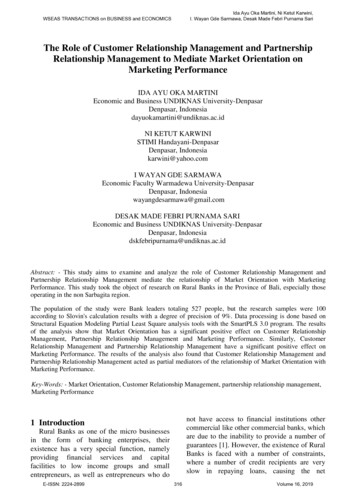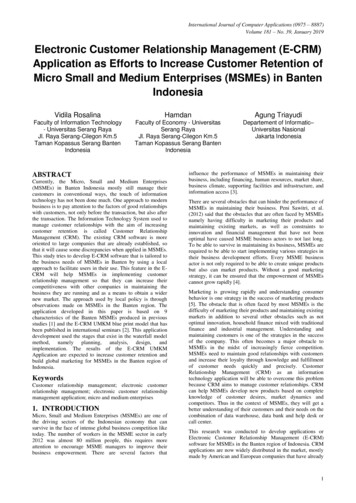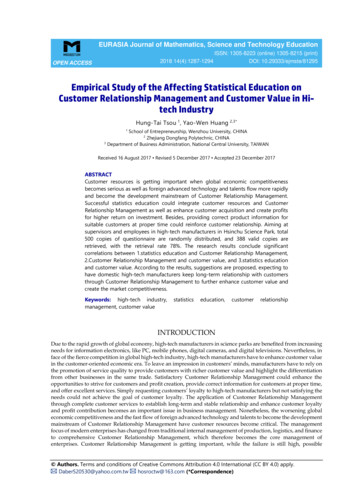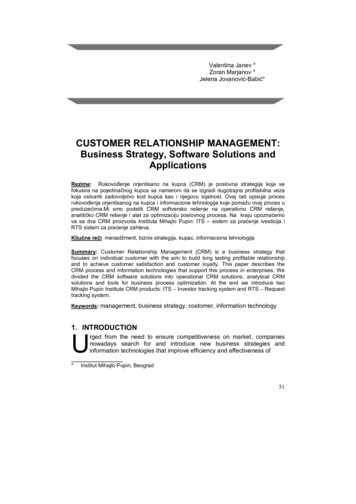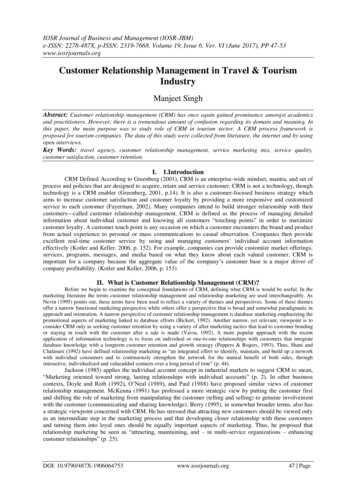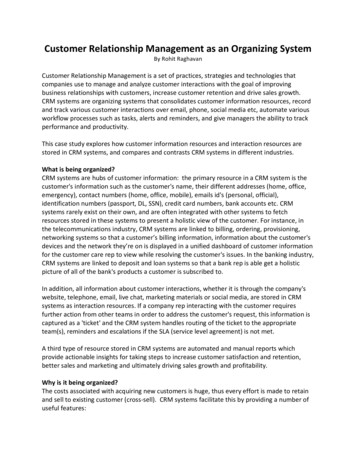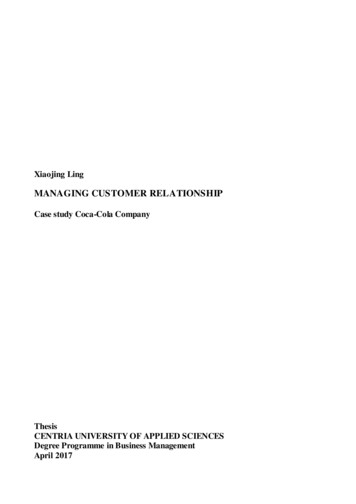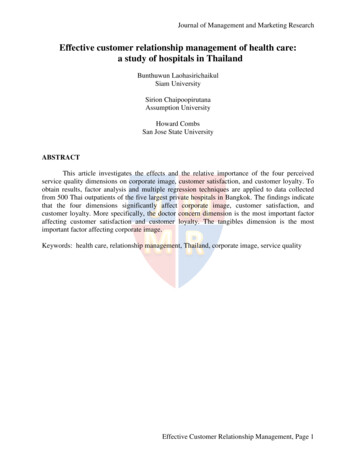
Transcription
Journal of Management and Marketing ResearchEffective customer relationship management of health care:a study of hospitals in ThailandBunthuwun LaohasirichaikulSiam UniversitySirion ChaipoopirutanaAssumption UniversityHoward CombsSan Jose State UniversityABSTRACTThis article investigates the effects and the relative importance of the four perceivedservice quality dimensions on corporate image, customer satisfaction, and customer loyalty. Toobtain results, factor analysis and multiple regression techniques are applied to data collectedfrom 500 Thai outpatients of the five largest private hospitals in Bangkok. The findings indicatethat the four dimensions significantly affect corporate image, customer satisfaction, andcustomer loyalty. More specifically, the doctor concern dimension is the most important factoraffecting customer satisfaction and customer loyalty. The tangibles dimension is the mostimportant factor affecting corporate image.Keywords: health care, relationship management, Thailand, corporate image, service qualityEffective Customer Relationship Management, Page 1
Journal of Management and Marketing ResearchINTRODUCTIONThe healthcare industry in Thailand is highly competitive as it has opened to the privatesector (Hasin, Seeluangsawat, and Shareef, 2001). At present, the competition is even moreintense given the high market value of the Thai healthcare industry. This has forced privatehospitals to compete with each other to gain as much market share as possible. As a result, manyprivate hospitals are more emphasizing more on marketing to compete for an increased marketshare (www.siamturakij.com, 2008a).In Thailand, total market value of all private hospitals in 2006 was over 49,000 millionbaht ( 1.5 billion) and this business is both globalizing and growing rapidly (www.thannews.th.Com, 2008). Private hospital has high potential in serving patients in Bangkok as the proportionof private hospitals in Bangkok accounted for 66.9% of health care in 2005 (www.moph.go.th,2008). Outpatients are the majority of private hospital’s customers accounting for 94.6% of totalpatients or 45.3 million in 2006 (www.nso.go.th, 2008). For these reasons, this study focused onThai outpatients of private hospitals in Bangkok.Corporate image, customer satisfaction, and customer loyalty may help servicecompanies to compete in this highly competitive environment. As corporate image will play anincreasingly important role in this environment of increasing competition and identical serviceofferings by attracting and retaining customers (Andreassen and Lindestad, 1998). In addition,customer satisfaction is considered by healthcare providers as a key component of strategy and asignificant determinant of long term viability and success under competitive situation (Andaleep,1998). Moreover, maintaining and expanding customer loyalty is significant for any servicecompany’s long term success (Kandampully, 1998).The delivery of consistently superior service quality has become a very importantprerequisite for many companies success (Parasuraman, Zeithaml, and Berry, 1988) because itaffects corporate image (Nguyen and LeBlanc, 1998), customer satisfaction (Lee, Lee and Yoo2000), and customer loyalty (Bloemer, Ruyter, and Wetzels, 1999). Accordingly, theimprovement of perceived service quality will enhance corporate image, customer satisfaction,and customer loyalty. As a result, the company can effectively compete and succeed in anincreasingly competitive environment.For the measurement of perceived service quality, this study applied perceived servicequality using four dimensions (i.e., doctor concern, staff concern, convenience of care process,and tangibles) from Choi et al. (2005) which is modified from the original dimensions ofSERVQUAL (Parasuraman et al., 1985, 1988). Although there is the criticism on SERVQUALthat it focuses only on measuring service process (GrÖnroos, 1990; Mangold and Babakus,1991), it is appropriate for healthcare service because customers (the patients) are unable toevaluate technical quality. Therefore, their evaluations are based on service process or functionalquality (Friedman, 1979).LITERATURE REVIEWBrand loyalty requires both psychological and behavioral measurements (Knox andWalker, 2001). Brand loyalty is conceptually identified as the biased (i.e. non-random),behavioral response (i.e. buy), expressed over time, by some decision making unit (i.e.individual, family, or company), with respect to one or more chosen brands out of a set of suchbrands (i.e. considering a set of brands before “selecting in” and “selecting out” particularEffective Customer Relationship Management, Page 2
Journal of Management and Marketing Researchbrands), and is a function of psychological process (i.e. decision making, evaluative process) thatis developed to some degree of commitment toward a brand or multi-brands by consumers. Thecommitment is a significant factor in distinguishing brand loyalty from simple repeat purchasebehavior (Jacoby and Kyner, 1973).Similarly, customer loyalty is defined as a very strong commitment to repurchase or repatronize a preferred product or service consistently in the future and a resistance in switchingbrand, although having powerful situational influences and marketing efforts (Oliver, 1999). Inaddition, Oliver (1999) suggested that true brand loyalty exists when all three decision makingphases: (1) beliefs (cognitive); (2) affect (affective); and (3) intention (conative), are pointedtoward a single brand preference. Cognitive loyalty occurs when consumer belief in one brand ispreferable to alternatives because of the knowledge and/or the information about brandattributes. Affective loyalty occurs when the consumer likes and has good attitudes toward onespecific brand. At this stage, the consumer has both cognition and affective loyalty in his/hermind. Conative loyalty occurs when consumer has behavioral intention toward a specific brand.Oliver (1980) found that customer satisfaction can be affected by expectation anddisconfirmation. Expectation is seen as an adaptation level or a reference point used to compareactual performance with the perceived performance. The comparison resulted in disconfirmation.If perceived performances are higher than the reference point (expectation), it results in positivedisconfirmation. If the perceived performances are lower than the expectation, it results innegative disconfirmation. These disconfirmation effects will make the post-decision deviate fromthe adaptation level. Then, the total effects cause customer (dis)satisfaction.Ross et al. (1987) concluded that patient (dis)satisfaction is the result of an interactionbetween expectations and perceived performance of service. If the patient has a positiveexpectation and it is substantially disconfirmed by perception of poor service performance, thenthe patient will be dissatisfied. The opposite is also true.Oliver (1981) defined customer satisfaction as “an evaluation of the surprise inherent in aproduct acquisition and/or consumption experience”. Parasuraman, Zeithaml, and Berry (1988)found that satisfaction is related to a specific transaction, whereas, service quality is a globaljudgment relating to the service’s superiority. Similarly, Patterson (1993) found that consumerscompare between perceived performance (P) and prior expectation (E), which results in negativeconfirmation (when P E), confirmation (when P E), and positive confirmation (when P E).Negative confirmation often tends to lead to a customer’s dissatisfaction. Confirmation is likelyto lead to customer (merely) satisfaction. Lastly, positive disconfirmation tends to lead to agreater level of customer satisfaction.GrÖnroos (1984) discovered that corporate image is extremely important for serviceorganizations because customers can typically see the firm and its resources when they useservice as it requires an interaction of customers with the service providers. He found that thecorporate image forms as a result of how customers perceive the components of the firm thatthey can see. The most salient part that customers can see and perceive is the firm’s service.Therefore, image may be built up mainly by the technical and functional quality of firm’sservice.Kurtz and Clow (1998) defined the corporate image or firm image as “the overall orglobal opinion customers have of a firm or organization”. If customers perceive the company ashigh image, they tend to patronize it. On the other hand, if company’s good image is damaged,customer will be dissatisfied and are not likely to return to the company. Moreover, they will telltheir negative experiences to others.Effective Customer Relationship Management, Page 3
Journal of Management and Marketing ResearchChoi et al. (2005) reported that most past studies on healthcare industry adopt processquality in measuring perceived service quality. GrÖnroos (1990) analyzed that the SERVQUALinstrument focuses on measuring service process (process quality). Choi et al. (2005) developedthe measurement of perceived service quality through modifying SERVQUAL’s dimensions andscales (Parasuraman, Zeithaml, and Berry, 1985, 1988; Parasuraman, Berry, and Zeithaml, 1990)in order to fit with Korean health care system. The SERVQUAL is a 22-items instrument used tomeasure consumer perceptions of service quality. The 22-items spread in five dimensions:tangible, reliability, responsiveness, assurance, and empathy (Parasuraman, Zeithaml, and Berry,1988).Choi et al. (2005) conducted 3 focus group interviews and found that the process qualitywas the main concern for Korean patients. This quality composed of four dimensions: physicianconcern, staff concern, convenience of care process, and tangibles. In the first stage, there aretotally 30 questions developed from the focus group interviews and SERVQUAL scale items(Parasuraman, Zeithaml, and Berry, 1990). After measurement analysis and purification, thescale items are reduced down to 19 items and the four dimensions is confirmed in validity. TheSERVQUAL is modified to fit with service quality of hospital in Korea where health care systemis different from U.S. and Europe. Patients in the Korean health care system have the freedom toselect the hospital (Choi et al., 2005) which is similar to Thai health care system where patientshave the right to change medical service providers and medical service.Image may be built up mainly by both the technical and the functional quality of thecompany’s service (GrÖnroos, 1984). Smith and Clark (1990) reported that quality of physician,advanced technology, and overall quality all have a strong and positive relationship with thehospital image. Similarly, Nguyen and LeBlanc (1998) explained that the collective perceptionof service quality from repeated service encounters is expected to form the overall corporateimage of the company.In addition, service quality is an antecedent of customer satisfaction (Cronin and Taylor,1992, Fornell, 1992; Oliver and DeSarbo, 1988). Also, Anderson, Fornell, and Lehmann (1994)proposed that customer satisfaction is affected by overall quality, expectations, and price.Moreover, Lee, Lee, Yoo (2000) summarized that consumer will be (dis)satisfied with serviceonly after they perceive and experience the service. It implied that service quality’ evaluationmay come before customer satisfaction.Bloemer, Ruyter, and Wetzels (1999) reported that some perceived service qualitydimensions affect some service loyalty dimensions in all four industries including health care.Cronin, Brady, and Hult (2000) found a direct relationship between service quality andbehavioral intention (a component of customer loyalty) across six difference service industriesincluding health care. Petrick (2004) found that service quality has a direct influence onrepurchase intention and that positively relates to positive word of mouth. Repurchase intentionand word of mouth are components of customer loyalty. These indicate that perceived servicequality has a direct influence on customer loyalty.Accordingly, this study investigates the effects of the four perceived service qualitydimensions on corporate image, customer satisfaction, and customer loyalty of Thai outpatientsof private hospitals in Bangkok. The hypotheses are defined in order to test the effects of fourperceived service quality dimensions on corporate image, customer satisfaction, and customerloyalty in conceptual framework as follows:H1o: Four dimensions of perceived service quality do not affect corporate image.H1a: Four dimensions of perceived service quality affect corporate image.Effective Customer Relationship Management, Page 4
Journal of Management and Marketing ResearchH2o:H2a:H3o:H3a:Four dimensions of perceived service quality do not affect customer satisfaction.Four dimensions of perceived service quality affect customer satisfaction.Four dimensions of perceived service quality do not affect customer loyalty.Four dimensions of perceived service quality affect customer loyalty.RESEARCH METHODOLOGYDescriptive research and survey research techniques were applied in this study. Theprimary data was collected by distributing questionnaires to 500 Thai outpatients at five largestprivate hospitals in Bangkok. The five largest private hospitals were selected based on thejudgment sampling technique by using the number of beds as a criterion. Thereafter, quotasampling is applied to equally distribute 100 questionnaires to each one of the five hospitals (seeTable 1).The questionnaire comprises two screening questions and another 5 parts. For the firstpart, there are 19 questions on perceived service quality variables and the questions aredeveloped from the study of Choi et al. (2005). The second part contains 3 questions on imagevariable and the third part contains four questions on customer satisfaction variable. Thequestions of part three and four are taken from Clow, Fischer, and Bryan (1995). The forth partconsists of three questions on customer loyalty.The study applied Cronbach’s coefficient alpha as a tool to measure the internalconsistency of the construct or concept (Sekaran, 2003). If the value is less than or equal to 0.6,it indicates that the internal consistency is unsatisfactory (Malhotra, 2004). All variables in thisstudy have Cronbach’s alpha greater than 0.6 indicating the satisfactory results: doctor concern(α 0.846), staff concern (α 0.857), convenience of the care process (α 0.797), tangibles (α 0.819), corporate image (α which are developed from Beerli, Martín, and Quintana (2004).Part 1 to part 4 are measured by using a five-point Likert scale, ranging from strongly disagree(1) to strongly agree (5). The last part is a demographic profile which contains questions abouteach respondent’s gender, age level, occupation, educational level and monthly personal incomelevel.RESULTS AND CONCLUSIONFactor analysis and multiple linear regression techniques were applied for data analysis.For factor analysis, the researchers extracted factors by using Varimax orthogonal rotation underprincipal component analysis (Ho, 2006). Moreover, Factor loadings should be greater than 0.3to be important (Field, 2000). In addition, the factor scores are used for further analysis as factorsscores can be used to solve multicollinearity problem for multiple regression analysis (see Field,2000).The results indicated that factor analysis is appropriate with the sample data (KMO’svalue 0.916; sig. value of Bartlett’s Test .000). Moreover, the four dimensions extracted areidentical to four perceived service quality dimensions of Choi et al. (2005). The first dimensionextracted is ‘doctor concern’ which compose of psqdoc1-5, the second dimension is ‘staffconcern’ including psqstaf1-5, the third dimension is ‘tangibles’ containing psqtan1-4, and thefourth dimension is ‘convenient of the care process’ containing psqpro1-5 (See Table 2).Therefore, the four dimensions are used for hypothesis testing.Effective Customer Relationship Management, Page 5
Journal of Management and Marketing ResearchFrom Table 3, four dimensions of perceived service quality affect corporate image (H1o:all P-value .000), customer satisfaction (H2o: all P-value .000), and customer loyalty (H3o:all P-value .000). Also, ‘doctor concern’ is the most important factor affecting customersatisfaction (Beta value 0.390) and customer loyalty (Beta value 0.350) and the second mostimportant factor affecting corporate image (Beta value 0.372). Then, ‘staff concern’ is thesecond most important factor that has an impact on customer satisfaction (Beta value 0.387)and customer loyalty (Beta value 0.284). In addition, ‘tangibles’ is the most important factorinfluencing corporate- image (Beta value 0.437). Lastly, although ‘convenience of the careprocess’ is the third and fourth important factors affecting corporate image (Beta value 0.187),customer satisfaction (Beta value 0.252), and customer loyalty (Beta value 0.262), it stillsignificantly affects all these variables. Therefore, one should not ignore this dimension.RECOMMENDATIONSThe results of this research indicated that ‘doctor concern’ is the most important factoraffecting customer satisfaction and customer loyalty and the second most important factoraffecting corporate image (see Table 3). Therefore, the management should hire the right peopleas experts and well-known doctors to serve their patients as they lead to reputation and positiveimage of the hospital. Moreover, the doctors should be trained on interpersonal skills so as toprovide politeness, comfort, and individual attention to their patients.Next, ‘staff concern’ is the second most important factor affecting customer satisfactionand customer loyalty. For nursing staff, the management should hire a service minded nursingstaff. The nursing staff and other hospitals staff should be trained on interpersonal skill toprovide care, empathy, and courtesy to patients.Furthermore, ‘tangibles’ is the most important factor influencing corporate image.Management should provide clean facilities e.g. patient examination room and toilet. Moreover,clean and fresh odor is also important for hospitals in reducing patients’ stresses. Hospital shouldprovide enough amenities (e.g. public telephones, seating, and toilets etc.) for both patients andtheir family members and friends. Also, hospital should provide up to date care facilities as it cancommunicate professionalism. For signs, symbol, and artifacts, management should provideadequate signs in communicating direction, location name, and room number so that patients caneasily find ways to the designated place. Moreover, the sign must be easy to read and very clearfor everyone.In addition, ‘convenience of the care process’ should be improved especially for waitingtime because this items has the lowest mean (mean 3.36 and SD 1.045). Therefore, thehospital should improve the waiting process. Finally, the hospital’s management shouldcontinue to collect data about perceived service quality of outpatients on regular basis. This waythey can keep track on perceived service quality of their hospital and continuously improve theirservice quality.REFERENCESAndaleep, S.S. (1998), Determinants of Customer Satisfaction with Hospitals: a ManagerialModel, International Journal of Health Care Quality Assurance, Vol. 11, No. 6, pp. 181187.Effective Customer Relationship Management, Page 6
Journal of Management and Marketing ResearchAnderson, E.W., Fornell, C., and Lehmann, D.R. (1994), Customer Satisfaction, Market Share,and Profitability: Findings from Sweden, Journal of Marketing, Vol. 58, pp. 53-66.Andreassen, T.W. and Lindestad, B. (1998), Customer Loyalty and Complex Services: TheImpact of Corporate Image on Quality, Customer Satisfaction and Loyalty for Customerswith Varying Degrees of Service Expertise, International Journal of Service IndustryManagement, 1998, vol. 9, No.1, pp 7-23.Beerli, A., Martín, J.D., and Quintana, A. (2004), A Model of Customer Loyalty in the RetailBanking Market, European Journal of Marketing, Vol. 38, No. 1/2, pp. 253-275.Bloemer, J., Ruyter, K., and Wetzels, M. (1999), Linking Perceived Service Quality and ServiceLoyalty: a Multi-dimensional Perspective, European Journal of Marketing, Vol. 33 No.11/12, pp. 1082-1106.Choi, K.S., Lee, H., Kim, C., and Lee, S. (2005), Service Quality Dimensions and PatientSatisfaction Relationships in South Korean: Comparisons Across Gender, Age, andTypes of Service, Journal of Services Marketing, Vol. 19, No. 3, pp. 140-149.Clow K.E., Fischer, A.K., and Bryan, D.O. (1995), Patient Expectations of Dental Services:Image Affects Expectations, and Expectations Affect Perceived Service Quality, Journalof Health Care Marketing, Vol.15, No.3, pp. 23-31.Cronin, J.J. and Taylor, M.K. (1992), Measuring Service Quality: A Reexamination andExtension, Journal of Marketing, Vol. 56, pp. 55-68.Cronin, J.J., Brady, M.K., and Hult, G.T.M. (2000), Assessing the Effects of Quality, Value, andCustomer Satisfaction on Consumer Behavioral Intention in Services Environments,Journal of Retailing, Vol. 76, No. 2, pp. 193-218.Field, A. (2002), Discovering Statistics Using SPSS for Windows, Sage PublicationsFornell, C. (1992), A National Customer Satisfaction Barometer: the Swedish Experience,Journal of Marketing, Vol. 56, p. 6-12.Friedman, H.S. (1979), Non-verbal Communications Between Patients and MedicalPractitioners, Journal of Social Issues, Vol.35, pp. 298-304GrÖnroos, C. (1984), A Service Quality Model and its Marketing Implications, EuropeanJournal of Marketing, Vol. 18, No.4, pp. 36-44.GrÖnroos, C. (1990), Service Management and Marketing, Lexington Books, Lexington, MAHasin, M.A.A., Seeluangsawat, R., and Shareef, M.A. (2001), Statistical Measures of CustomerSatisfaction for Health Care Quality Assurance, International Journal of Health CareQuality Assurance, Vol.14, No. 1, pp. 6-13.Ho, R. (2006), Handbook of Univariate and Multivariate Data Analysis and Interpretation withSPSS, Chapman & Hall/CRC, Taylor & Francis Group.Jacoby, J. and Kyner, D.B. (1973), Brand Loyalty vs. Repeat Purchasing Behavior, Journal ofMarketing Research, Vol. 5, pp. 1-9.Kandampully, J. (1998), Service Quality to Service Loyalty: A Relationship Which GoesBeyond Customer Services, Total Quality Management, Vol. 9, No. 6, pp. 431-443.Knox, S. and Walker, D. (2001), Measuring and Managing Brand Loyalty, Journal of StrategicMarketing, Vol. 9, pp. 111-128.Kurtz, D.L. and Clow, K.E. (1998), Service Marketing, John Wiley & Sons.Lee, H., Lee, Y., and Yoo, D. (2000), The Determinants of Perceived Service Quality and itsRelationship with Satisfaction, Journal of Service Marketing, Vol.14, No.3, pp. 217-231.Malhotra, N.K. (2004), Marketing Research: An Applied Orientation, Pearson Prentice Hall.Effective Customer Relationship Management, Page 7
Journal of Management and Marketing ResearchMangold, G.W. and Babakus, E. (1991), Service Quality: the Front-stage Perspective vs theBack-stage Perspective, Journal of Services Marketing, Vol. 5, No. 4, pp. 59-70.Nguyen, N. and LeBlanc, G. (1998), the Mediating Role of Corporate Image on Customers’Retention Decisions: an Investigation in Financial Services, International Journal ofBank Marketing, Vol. 16, No.2, pp. 52-65.Oliver, R.L. (1980), A Cognitive Model of the Antecedents and Consequences of SatisfactionDecisions, Journal of Marketing Research, Vol. 17, 460-469.Oliver, R.L. (1981), Measurement and Evaluation of Satisfaction Process in Retail Settings,Journal of Retailing, Vol. 57, No. 3, pp. 25-48.Oliver, R.L. (1999), Whence customer loyalty?, Journal of Marketing, Vol. 63, Special issue, pp.33-44.Oliver, R.L. and DeSarbo, W.S. (1988), Response Determinants in Satisfaction Judgments,Journal of Consumer Research, Vol. 14, pp. 495-507.Parasuraman, A, Berry, L.L., and Zeithaml, V.A. (1990), An Empirical Test of the ExtendedGaps Model of Service Quality, working Paper, No. 90-122, Marketing Science Institute,Cambridge, MA.Parasuraman, A., Zeithaml, V.A., and Berry, L.L. (1985), A Conceptual Model of ServiceQuality and its Implications for Future Research, Journal of Marketing, Vol. 49, Fall, pp.41-50.Parasuraman, A., Zeithaml, V.A., and Berry, L.L. (1988), SERVQUAL: A Multiple-item Scalefor Measuring Consumer Perceptions of Service Quality, Journal of Retailing, Vol. 64,No. 1, pp. 12-40.Patterson, P.G. (1993), Expectations and Product Performance as Determinants of Satisfactionfor a High-involvement Purchase, Psychology and Marketing, Vol. 10, No. 5, pp. 449465.Petrick, J.F. (2004), The Role of Quality, Value, and Satisfaction in Predicting CruisePassengers’ Behavioral Intentions, Journal of Travel Research, Vol. 42, pp. 397-407.Ross, C.K., Frommelt, G., Hazelwood, L., and Chang, R.W. (1987), The Role of Expectations inPatient Satisfaction with Medical Care, Journal of Health Care Marketing, Vol. 7, No. 4,pp 16-26.Sekaran, U. (2003), Research Methods for Business: A Skill Building Approach, John Wiley &Sons.Smith, S.M. and Clark, M. (1990), Hospital Image and the Positioning of Service Centers: anApplication in Market Analysis and Strategy Development, Journal of Health CareMarketing, Vol. 10, No.3, pp. 13-22.Websites http://www.siamturakij.com/home/news/print news.php?news id 5880 .php?id M2221802&issue 2304 (23/03/2008)http://www.moph.go.th/ops/health 50/2548 2550.html h/service/survey/hospital pre50.pdf (18/01/2008)http://www.tmc.or.th/privilege.php (20/02/2008)http://203.157.6.200/king/ac/stat.asp (22/02/2008)Effective Customer Relationship Management, Page 8
Journal of Management and Marketing ResearchAPPENDIX: QUESTIONNAIREPerceived Service Quality (developed from Choi et al., 2005)1. The doctor was polite.2. The doctor adequately explained my condition, examination results, and treatmentprocess.3. The doctor allowed me to ask many questions, enough to clarify everything.4. The doctor paid enough consideration to my concerns for deciding medical procedure.5. The doctor made me feel comfortable.6. Hospital staffs (e.g. nursing staffs, pharmacist, receptionist, and cashier excludingdoctors) were friendly and polite.7. Nursing staffs thoroughly explained the medication process.8. Nursing staffs tried to help me as much as they could.9. Nursing staffs sincerely cared for me.10. There was a good coordination among hospital staffs excluding doctors.11. The procedure of the lab test (e.g. blood checking and urine checking) was convenient.12. The lab test’s result was done in a prompt way.13. The payment procedure was quick and simple.14. The process of making the appointment with doctor was simple and easy.15. I did not have to wait long for the medical examination from the doctor.16. The waiting area for medical examination, medical examination room, waiting area forpayment, and toilet were clean.17. It was easy to use the amenities (e.g. cafeteria, public telephone etc.) in this hospital.18. The hospital has up-to-date care facilities (e.g. medical equipments, laboratories, medicalexamination room etc.).19. It was easy to find way to care facilities (e.g. laboratories, medical examination roometc.) and amenities (e.g. cafeteria, public telephone etc.).Effective Customer Relationship Management, Page 9
Journal of Management and Marketing ResearchFigure 1: The determinants of image, customer satisfaction, and customer loyalty based onperceived service quality: perceptions of Thai outpatients of private hospitals in Thailand.Corporate ImagePerceived Service Quality- Doctor Concern- Staff Concern- Convenience of theCare Process- TangiblesCustomer SatisfactionCustomer LoyaltyTable 1: Five Largest Private Hospitals in Bangkok in 2007 and Number of QuestionnairesHospital’s NameNumber ofquestionnaires1.Bumrungrad InternationalHospital (554 beds)1002.Phyathai 2 Hospital(550 beds)1003.Kasemrad Bangkok Hospital(500 beds)1004.Hua Chiew Hospital(450 beds)1005.Thonburi Hospital (435 beds)100Total500Source: http://203.157.6.200/king/ac/stat.asp (2008)Effective Customer Relationship Management, Page 10
Journal of Management and Marketing ResearchTable 2 The result of factor analysis on perceived service qualityRotated Component .502Extraction Method: Principal Component Analysis.Rotation Method: Varimax with Kaiser Normalization.a. Rotation converged in 6 iterations.Effective Customer Relationship Management, Page 11
Journal of Management and Marketing ResearchTable 3: Summary of Hypothesis Testing ResultsF-valueP-valueSignificant levelResults106.812.000.05Reject HoStandardized BetaP-valueSignificant levelResultsDoctor concern.372.000.05Staff concern.314.000.05Tangibles.437.000.05Convenience of the care process.187.000.05F-valueP-valueSignificant levelResults89.077.000.05Reject HoStandardized BetaP-valueSignificant levelResultsDoctor concern.390.000.05Staff concern.387.000.05Tangibles.230.000.05Convenience of the care process.252.000.05F-valueP-valueSignificant levelResults55.521.000.05Reject HoStandardized BetaP-valueSignificant levelResultsDoctor concern.350.000.05Staff concern.284.000.05Tangibles.195.000.05Convenience of the care process.262.000.05HypothesisH1o: Four dimensions of perceivedservice quality do not affect oncorporate image.HypothesisH2o: Four dimensions of perceivedservice quality do not affect oncustomer satisfaction.HypothesisH3o: Four dimensions of perceivedservice quality do not affect oncustomer loyalty.Reject HoandSupport HaReject HoandSupport HaReject HoandSupport HaEffective Customer Relationship Management, Page 12
Effective Customer Relationship Management, Page 1 Effective customer relationship management of health care: a study of hospitals in Thailand . (GrÖnroos, 1984). Smith and Clark (1990) reported that quality of physician, advanced technology, and overall quality all have a strong and positive relationship with the hospital image. .
